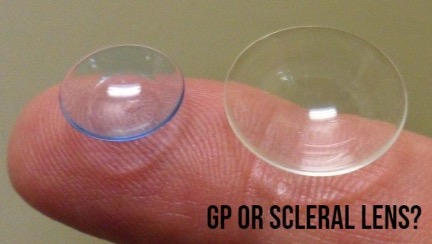Scleral Lenses Popular Among KC Community

A Case of Unilateral Keratoconus?
January 11, 2023
December 2022 Update Newsletter
February 10, 2023For more than 50 years, if you asked someone with keratoconus about their contact lenses, chances are they were wearing ‘hard’ or ‘rigid’ gas permeable (GP) lenses. In most cases, these lenses offered the best vision for an individual with keratoconus. Patients who could not tolerate GP lenses were forced to consider a corneal transplant.
Doctors at the University of Illinois at Chicago conducted a medical records review of new patients in their keratoconus clinic for the year 2020 and compared the findings to a review for the year 2010. They found that there were 292 eligible patients in 2010 and 217 patients a decade later. While there were fewer patients in 2020, they had more severe keratoconus based on steepness of their corneas and their vision. The authors theorize that many patients with mild or moderate keratoconus are now treated effectively in the community, leaving those with the most severe disease to receive care at an academic medical center. Patients in 2020 achieved better corrected vision than what has recorded in 2010.
GP lenses are still the most common treatment for keratoconus. In 2010, 69% of the lenses prescribed by the clinic doctors were GP lenses. That fell to 60% by 2020. In 2010, the clinic did not prescribe a single scleral lens. By 2020, more than 1 in 5 patients (22%) were being fit into scleral lenses.
A previous survey of optometrists revealed that most optometrists fit their first scleral lenses between 2010 and 2015. Scleral lens education is now an established part of the curriculum; any optometrist trained in the last decade has as much experience fitting scleral lenses as GP lenses.
Scleral lenses give doctors another option to offer patients for vision rehabilitation. The ability to achieve a good fit and good vision with all types of contact lenses continues to improve; even patients with advanced disease are seeing better than they ever were.
Reference: Scanzera A, Deeley M, Joslin C, et al, Contact Lens Prescribing Trends for Keratoconus at an Academic Medical Center: Increased Utilization of Scleral Lenses for Severe Disease, Eye & Contact Lens, 48:58-62, 2022.
Nau C, Harthan J, Shorter E, et al, Demographic Characteristics and Prescribing Patterns of Scleral Lens Fitters: The SCOPE Study, Eye Contact Lens, 44:S265-S272, 2018.



